



The anode of lithium ion battery is typically comprised of graphite, the electrolyte is typically made of organic carbonate solvents involved dissolved lithium salts (often LiPF6), and the cathode varies in different chemical composition. According to the cathode chemistry composition, lithium ion battery which is mainly used to power electric vehicles includes lithium iron phosphate(LFP lithium ion battery),lithium nickel cobalt aluminum oxide(NCA), lithium nickel manganese cobalt oxide(NCM)lithium manganese oxide(LMO)and Lithium tantalite oxide (LTO). The comparison between different lithium ion battery chemistries is shown in sheet 1. Moreover, lithium ion battery from lithium ion battery China manufacturer which can power electric vehicles have three types of form: cylinder, pouch, and prismatic (See figure 2).
Figure 2: Types of lithium ion battery
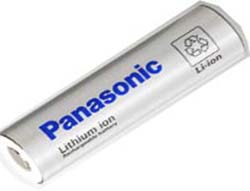
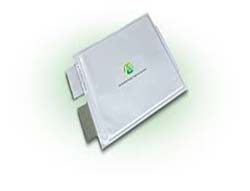
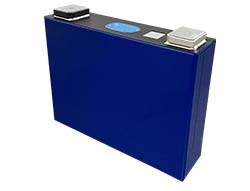
Cylindrical battery and prismatic battery both are with outer solid and metal shell. Prismatic battery for electric vehicles primarily delivers in the format of the high capacity, and this offers a simple assembly procedure of battery system. But the prismatic battery allows flexible design (TWAICE, 2019), this leads to the various sizes of prismatic battery, in other words, this means the instability of production because of frequently adjusting production lines for different sizes of battery. A major advantage of cylindrical cells is the long experience in the production of cylindrical design, the small cylindrical cells are made in very high volumes by automated manufacturing and the price is less expensive than prismatic and pouch for standard shapes, but the small size of cylindrical battery exists weakness of high difficulty and risk of battery system integration, especially complicated assembly process and cooling system as well as the monitoring effort required during operation (Ampow Blog, 2019). Compared with prismatic battery and cylindrical battery, a pouch battery is enclosed by a flexible, mostly aluminum-based outer foil. It allows flexible design which is same with prismatic battery, pouch battery not only is light and cost-effective, but also the pouch shell allows most efficient use of space and is able to packaging efficiency of 90–95%. But expanding after some cycles is the primary issue (Ampow Blog, 2019). Learn more about types of li ion battery wholesale and contact custom lithium ion battery manufacturers.
Sheet1: Comparison between different lithium ion battery chemistries
(Batteryuniversity.com, 2020)
Item | LFP | NCA | NMC | LTO | LMO |
Normal Voltage(V) | 3.20 | 3.60 | 3.60 | 2.40 | 3.70 |
Operation voltage(V) | 2.5–3.65 | 3.0–4.2 | 3.0–4.2 | 1.8–2.85 | 3.0–4.2 |
Energy density (Wh/kg) | 90–180 | 200-260 | 150–220 | 50–80 | 100–150 |
Charging(C-rate) | 1C | 0.7C | 0.7–1C | 1C (Max 5C) | 0.7–1C (Max 3C) |
Discharging(C-rate) | 1C | 1C | 1C | 10C | 1C |
Cycle life | ≥2000 | 500 | 1000–2000 | 3,000–7,000 | 300–700 |
Thermal runaway | 270°C (518°F) | 150°C (302°F) | 210°C (410°F) | NA | 250°C (482°F) |
Prone to thermal runaway | No | Yes | Yes | No | Yes |
Relative cost | $ | $ | $ | $$$ | $$ |
Comments | Moderate growth | Growth potential | Dominant cathode chemistry | High cost limits to special application. | Limited growth potential. |
Sheet1 shows a comparison between different lithium-ion battery chemistries. The following information is summarized to mark the technical pathway of lithium ion battery.
LTO excels in safety, cycle life and charging rate, but the low energy density and high-cost limit the application in electric vehicles.
LMO is moderate in overall performance; most LMO battery blend with NCM to improve the energy density and prolong the cycle life. So typically, LMO (NMC) is chosen for electric vehicles application but existing limited growth potential.
LFP has excellent performance of safety and long cycle life but moderate energy density. LFP is primarily used in energy storage and the special vehicles which have a low requirement to battery energy density, high demand for battery safety performance.
NMC is the most favorable chemistry for many automobile manufacturers, and NMC market share is increasing due to NMC can be built economically and it achieves excellent performance. Nickel ingredient can contribute to the energy density of cathode material; Manganese and Cobalt help the chemical and structural stability of cathode material in a broad sense. The price of Manganese and Nickel is relatively steady and low; the cost of Cobalt is sensitive and expensive. The three materials of Nickel, Manganese and Cobalt effectively can be blended to output a wide of performance, so the NMC family is growing in its diversity, which includes NMC111, NMC532, NMC622 and the newest NMC811(See figure 3). NMC 811 will be better and cheaper, which is the next generation cathode to push the driving range of electric vehicles above 500km and accomplish price parity with the internal combustion engine soon (Research Interfaces, 2018). However, there are a lot of debates about the safety of high Nickel lithium ion battery. Kim et al. (2018) and Hou et al. (2017) state that the reduction of Manganese and Cobalt and increase of unstable Nickel will most likely lead to threatening the structural stability of cathode material
Figure 3: Comparison of NMC cathode compositions and their energy density
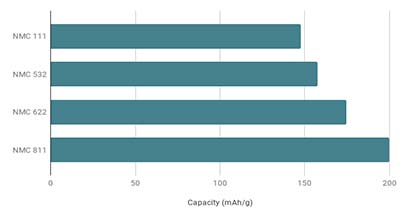
NCA is consist of three materials of Nickel, Manganese and Aluminum, typically 80% Nickel and 15% Cobalt, but 5% aluminum as opposed to Manganese.NCA shows high similarities with NMC by offering higher energy density but less cycle life than NCM from the battery level. NCA is also expected to another dominate customer requirements for the foreseeable future because of the vehicle performance success of Tesla electric vehicle combined by Panasonic cylinder batteries and Tesla's excellent battery management system. But the market size is relatively small excluding to Tesla/Panasonic.
The types of lithium-ion battery that Lithium Storage is supplying is prismatic lithium-ion battery, including LFP and NCM both chemistry. The capacity covers from 40Ah to 302Ah for each cell.
Based on the current rate, Lithium Storage not only supplies 1C continuous charge and discharge rate of LFP and NCM lithium-ion battery, bus also provides 6C high rate of lithium iron phosphate battery. In addition, for meeting different requirements in cycle life, Lithium Storage develops 6000 times long cycle LFP280Ah for projects that there is special demand in the service life of battery systems.
According to the characteristics of lithium-ion battery production technology, there are the following technology advantages:
• SCL die-cutting Technology
• Self-balance Technology
• Independent Structural Design in top cap
Other types of lithium batteries wholesale:
Associating with the development of the lithium-ion battery industry technology and increasing high production efficiency in battery installment, mainstream lithium battery manufacturers and battery system integrators have changed the installment mode of battery packs from cells-pack to cells-modules-pack. Lithium ion battery module can protect battery cells from external shock, vibration and heat, improving the reliability of battery packs.
Battery module: several battery cells put into a housing frame to protect them better from external shocks such as heat or vibration and output to the outside through sampling connectors and the positive and negative terminals of modules.
Battery pack: when a number of battery modules are connected together with a BMS (Battery Management System), a cooling or heating device, and protection components.
LITHIUM STORAGE supports offering standard battery modules and customization of battery modules based on LFP/NCM prismatic lithium cells, including the structure of the banding module and frame welding module. The high structural strength of the frame welding module meets harsh vehicle operating conditions, and the high flexibility of the banding module meets a wide range of dimension requirements.
In past ten years, with the development of the lithium ion battery industry technology and increasing high production efficiency in battery installment, lithium ion batteries has also undergone great generation.In order to increase the energy density, mainstream lithium battery manufacturers have updated the shell of lithium-ion batteries from plastic shells to aluminum shells. As well as for improving the production efficiency, the positive and negative terminals of lithium ion batteries have also been changed from screw hole terminals to flat welding terminals. These changes requires insulation design in battery pack installment and welding equipment in battery connection. Due to the total pack needs to be replaced once one cell of battery pack fails in the operation, many international customers still prefer to choose cells that can be connected by screw or bolts. Based on this market demand, LITHIUM STORAGE can offer different terminal solutions for cells with welding terminals, including screw terminals and Nut terminals. These solutions have passed the multiple inspection testing items such as drawing force, shear force and torque testing etc., and have been applied in the various electric vehicle and energy storage projects in the different countries. Wholesale lithium ion forklift battery, and lithium ion battery for electric bus for sale in bulk from LITHIUM STORAGE.
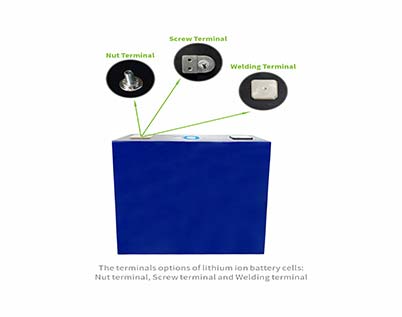
Screw terminals: screw terminals are a relatively more reliable way than nut terminals and their reliability has been verified for more than 5years in multiple application cases. The overall material of screw terminals is aluminum 6061 and one piece of block. Therefore, there is a good performance in torque and conductivity capability, up to 8N toque(suggest 6N) and 1C constant rate. There are two screw holes on the screw terminals and busbars can be fixed by M6*16 bolts. This option is suitable for lithium ion battery cells with a capacity greater than 200Ah.
Nut terminals: Depending on the different cell types and connection needs, nut terminals have M6*14, M6*16, M6*18 and M6*22. The stud materials are stainless steel and the bottom material is pure aluminum for easy welding. Lithium Storage designs platform structure to prompt the conductivity capability of nut terminals, meeting constant charge and discharge rate 1C. In addition, the welding quality of nut terminals is managed by the regulation of welding procedures. The nut terminal option is generally for the low capacity of lithium-ion battery cells.
Lithium ion battery is a kind of rechargeable battery, also called for "rocking chair battery", in the charged condition, the anode includes a high level of intercalated lithium while the cathode lacks lithium, lithium ions move through an electrolyte to accomplish from the negative electrode to the positive electrode during discharging, return when charging. The lithium ion battery is comprised of three major parts: anode, cathode, and electrolyte. The anode and cathode are connected electrically but separated physically by the electrolyte(Daniel, 2008). Learn more from the lithium ion battery manufacturers in China.
Figure 1: The smallest unit structure of lithium ion battery (Lee et al., 2014)
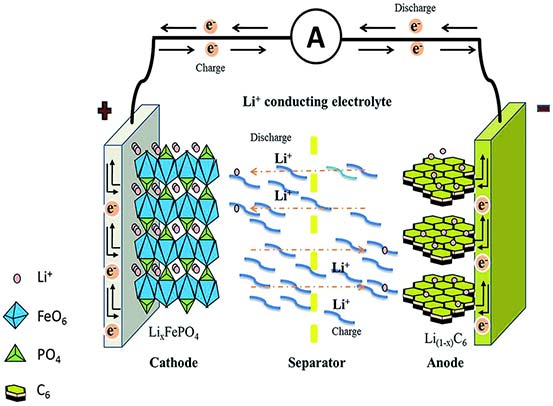
Because lithium ion batteries last so much longer than traditional lead acid batteries, the cost savings begin to add up quickly and end up being substantial over the much longer life span of this game-changing forklift power source.
Other factors that contribute to a more cost-efficient warehouse operation include:
· Far less money spent on energy for charging batteries
· Less time and labor expended by workers swapping out lead acid batteries
· Less time and labor spent maintaining and watering lead acid batteries
· Less energy wasted (a lead acid battery burns off 45-50% of its energy in heat, while a lithium battery loses only 10-15%)
Hydrogen fumes and “acid splash” are a health and safety concern for workers maintaining lead acid batteries. Risks include sulfuric acid contacting their clothing, skin or eyes. Though not always adhered to, OSHA guidelines call for nearby eyewash stations and for workers to wear personal protective gear (goggles, rubber or neoprene gloves and aprons). Such potential health and safety hazards are eliminated when using lithium batteries.
Due to the space needed for charging and the risk of spills and fumes, most companies that run multiple forklifts powered by lead acid batteries handle the time-consuming recharging tasks by dedicating some of their valuable warehouse space to a separate, well-ventilated battery room.
The one advantage of lithium storage battery is no memory effect. This allows forklift batteries can be charged during breaks or in between tasks without hurting lithium ion battery life span or performance. The same operation is apparant to shorten the life of lead acid batteries.
The characteristic of Lead acid decides that lead acid batteries must be carefully maintained for keeping in compliance with warranty terms according to the specifications of lead acid manufactures. In contrary, lithium batteries are essentially maintenance free and are offered longer warranties than lead acid battery.